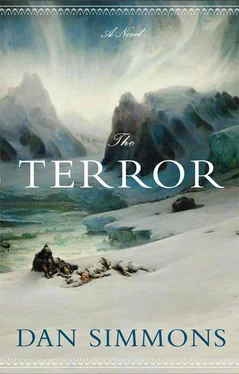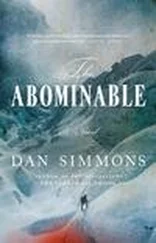Erebus was still in its final ten days of agony when Crozier had detached the best man-haulers from each ship – the winners of the biggest prizes and the last money Francis Crozier had in the world – given them the best-designed sledge, and ordered Mr. Helpman and Mr. Osmer, the purser, to fit this superteam of man-haulers out with everything they might need for six weeks on the ice.
It was an eleven-man sledge headed by Erebus second mate Charles Frederick Des Vouex, its lead puller the giant Manson. Each of the other nine men were asked to volunteer. Each man did.
Crozier had to know if it was possible to man-haul a fully loaded boat sledge across the open ice in such a straight dash toward rescue. The eleven men left at six bells on 23 March, in the dark, with the temperature at thirty-eight below zero, to three rousing cheers from every ambulatory crewman assembled from both ships.
Des Voeux and his men were back in three weeks. No one had died, but they were all exhausted and four of the men had serious frostbite. Magnus Manson was the only one of the eleven-man team, including the apparently indefatigable Des Voeux, who did not seem close to death from exhaustion and hardship.
In three weeks they had been able to travel less than twenty-eight miles in a straight line from Terror and Erebus . Des Voeux later estimated that they had man-hauled more than a hundred and fifty miles to gain those twenty-eight, but there was no possibility of traveling in a straight line that far out on the pack ice. The weather northeast of their current position was more terrible than the Ninth Circle of Hell where they had been trapped for two years. Pressure ridges were Legion. Some rose to heights greater than eighty feet. Even steering their course was close to impossible when clouds hid the southerly sun and the stars were hidden for several eighteen-hour nights on end. Compasses, of course, were useless this close to the north magnetic pole.
The team had brought five tents for safety’s sake, although they had planned to sleep in only two of them. The nights were so cold out on the exposed ice that the eleven men slept the last nine nights, when they were able to sleep at all, in a single tent. But in the end they’d had no choice in the matter, since four of the sturdy tents had blown away or been ripped to shreds by the twelfth night on the ice.
Somehow Des Voeux had kept them moving to the northeast, but every day the weather worsened, the pressure ridges grew closer together, the necessary deviations from their course became longer and more treacherous, and the sledge sustained serious damage in their Herculean struggle to haul and shove it over the jagged ice ridges. Two days were lost just repairing the sledge in the howl of wind and blowing snow.
The mate had decided to turn around on their fourteenth morning on the ice. With only one tent left, he gauged their chances of survival as low. They then tried to follow their own thirteen days of ruts back to the ships, but the ice was too active – shifting slabs, moving bergs within the pack ice, and new pressure ridges rising in front of them had obliterated their track. Des Voeux, the finest navigator on the Franklin Expedition except for Crozier, took theodolite and sextant readings in the few clear moments he found in the days and nights but ended up setting his course based mostly on dead reckoning. He told the men that he knew precisely where they were. He was sure, he later admitted to Fitzjames and Crozier, that he would miss the ships by twenty miles.
On their last night on the ice, the final tent ripped and they abandoned their sleeping bags and pressed on to the southwest blindly, man-hauling just to stay alive. They jettisoned their extra food and clothing, continuing to man-haul the sledge only because they needed their water, shotguns, cartridges, and powder. Something large had been following them for their entire voyage. They could see it through the spindrift and fog and pelting hail. They could hear it circling them each endless night in the darkness.
Des Voeux and his men were sighted on the northern horizon, still headed due west and oblivious of Terror three miles south of them, on the morning of their twenty-first day on the ice. An Erebus lookout had spotted them, but the ship itself was gone by then – crushed and splintered and sunk. It was Des Voeux’s and his men’s good fortune that the lookout, Ice Master James Reid, had climbed the huge iceberg that had been part of the Grand Venetian Carnivale before dawn that day and spotted the men through his glass just at first light.
Reid, Lieutenant Le Vesconte, Surgeon Goodsir, and Harry Peglar led the party that went out to fetch the Des Voeux team, bringing them back past the crushed timbers, tumbled masts, and tangled rigging that was all that remained of the sunken ship. Five of the Des Voeux champion team were not able to walk the last mile to Terror but had to be sledged there by their mates. The six Erebuses among the superteam of sledgers, including Des Voeux, wept at the sight of their destroyed home as they were led past it.
So… the short way northeast to Boothia was no longer an option. After debriefing Des Voeux and the other shattered men, both Fitzjames and Crozier agreed that a few of the 105 survivors might make it to Boothia, but the vast majority were certain to perish on the ice under such conditions, even with the longer days, slightly rising temperatures, and added sunlight. The possibility of open leads would only add to the hazard.
The choices now were either stay on the ships or set up a camp on King William Land with the option of making a run south to Back’s River.
Crozier began the planning for the evacuation the next day.
Just before sunset and their dinner stop, the procession of sledges came across a hole in the ice. They stopped, the five sledges and harnessed men making a ring around the pit. The black circle far below them was the first open water the men had seen in twenty months.
“This weren’t here last week when we brung the pinnaces to Terror Camp, Captain,” said Seaman Thomas Tadman. “You can see how close them runner tracks come to it. We would’ve seen it, sure like. There was nothing here.”
Crozier nodded. This was no ordinary polynya – the Russian word for one of those rare holes in pack ice that remained open all year long. The ice was more than ten feet thick here – less thick than the congealed pack ice around Terror but still solid enough to erect a London building on – but there was no sign of pressure slabs or cracking around this hole. It was as if someone or something had taken a gigantic ice saw of the sort both ships packed and cut a perfectly round hole through the ice.
But the ships’ ice saws would not cut so cleanly through ten feet of ice.
“We could take our dinner here,” said Thomas Blanky. “Enjoy our victuals by the seaside, as it were.”
The men shook their heads. Crozier agreed – he wondered if the others felt the same unease he did about the uncannily perfect circle, deep pit, and black water. “We’ll keep moving for another hour or so,” he said. “Lieutenant Little, have your sledge take the lead, please.”
It was perhaps twenty minutes later, the sun had set with an almost tropical suddenness and stars were shaking and twitching in the cold sky, when Privates Hopcraft and Pilkington, who had been serving as rear guard, crunched up to Crozier where he was walking beside the rearmost sledge. Hopcraft whispered, “Captain, there’s something following us.”
Crozier pulled his brass telescope from the top-lashed box on the sled and stood stationary on the ice with the two men for a minute while the sledges rasped their way past them into the gathering gloom.
Читать дальше












